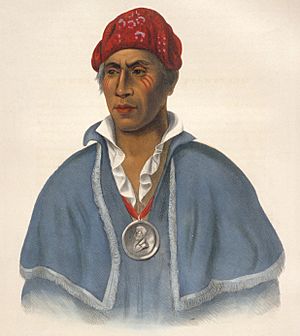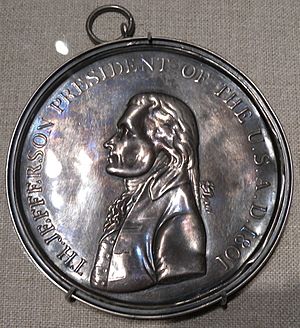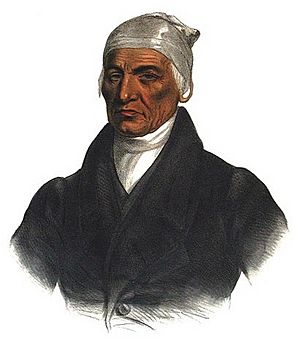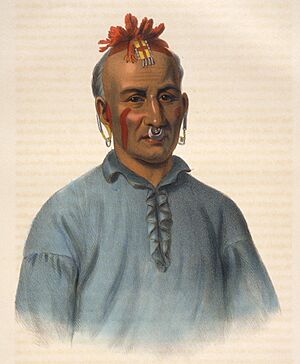John Lewis (Shawnee leader) facts for kids
Quick facts for kids
John Lewis
|
|
|---|---|
 |
|
| Born |
Quatawapea
c. 1760 |
| Died | 1826 (aged about 66) |
| Burial place | Unknown |
| Nationality | Shawnee |
| Other names | Captain Lewis, Colonel Lewis |
| Occupation | Village chief, diplomat, warrior |
| Known for | Leader of the Lewistown Shawnees |
Quatawapea or John Lewis (around 1760 – 1826) was an important Shawnee leader. He was also known as Captain Lewis and Colonel Lewis. The town of Lewistown, Ohio is named after him.
John Lewis fought in the American Revolutionary War (1775–1783) and the Northwest Indian War (1785–1795). He fought to stop the United States from taking more Shawnee land. After the 1795 Treaty of Greenville, he tried to keep the Shawnee people strong. He worked with Black Hoof, another main Shawnee leader, to find ways to live peacefully with the U.S.
During the War of 1812, Lewis helped the American army. After this war, he signed several treaties with the U.S. These treaties helped make Lewistown a special Indian reservation for his group of Shawnees and some Senecas. Lewis traveled to Washington, D.C. many times. He met with U.S. Presidents like Thomas Jefferson and James Monroe. He always worked to protect Shawnee land rights.
But American settlers kept moving onto Shawnee lands. This made Lewis believe that staying in Ohio was no longer possible. He disagreed with Black Hoof and thought the Shawnees should move west. He wanted to create a group of Native tribes with the Cherokees in Missouri and the Arkansas Territory. He died before this plan could happen. After his death, the Shawnees and Senecas of Lewistown had to give up their land in Ohio in 1831. They moved to Indian Territory. These Lewistown Shawnees later became the Eastern Shawnee Tribe of Oklahoma.
Contents
Early Life of John Lewis
We don't know much about John Lewis's early life or family. He was likely born around 1760 in the Ohio Country. This was in one of the Shawnee villages on the Pickaway Plains. This area is near what is now Circleville, Ohio.
Lewis's Shawnee name was Quatawapea. It was spelled in different ways. It meant "the Man Who Swims Below and Above the Water" or "Man on the Water Who Sinks and Rises Again." Shawnee people of Lewis's time belonged to one of five main groups. Lewis was probably from the Piqua group. Each Shawnee also belonged to a clan named after an animal. Lewis was part of the Turtle clan.
When Lewis was young, the Iroquois gave land south of the Ohio River to the British. This land included what is now Kentucky. The Shawnees used Kentucky for hunting. They were not asked about the 1768 Treaty of Fort Stanwix. The Shawnees tried to fight back against settlers moving into the area. This led to the 1774 Battle of Point Pleasant. Lewis fought in this battle when he was a young man. After losing, the Shawnees had to give Kentucky to the American colonists.
Shawnee people kept fighting American settlers during the American Revolutionary War (1775–1783). Lewis joined Shawnee groups that attacked settlements in Kentucky and Virginia. After the war, the Americans claimed the Ohio Country. But Native people kept fighting back. This led to the Northwest Indian War (1785–1795). Lewis fought in this war too. He was at St. Clair's defeat (1791) and the Battle of Fallen Timbers (1794). After losing at Fallen Timbers, the Shawnees had to give up much of present-day Ohio. This happened in the 1795 Treaty of Greenville. Lewis was probably there, but he did not sign the treaty.
In the mid-1780s, Lewis married Polly Baker. She was a white captive who had joined the Shawnee tribe as a child. They had two children. Later, he married Mary Succopanus. She was part Shawnee and part Mingo. They did not have children together.
Life in Lewistown

After losing the Northwest Indian War, the Shawnee people had different ideas. Some wanted to live peacefully with the United States. Others wanted to keep fighting. And some moved west of the Mississippi River. Lewis was among those who hoped to keep their Ohio lands by working with the U.S. Around 1796, he and his followers started the Shawnee village of Lewistown. It was in what is now Logan County, Ohio.
Near Lewistown were two other Shawnee villages: Hog Creek and Wapakoneta. Wapakoneta was home to Chief Black Hoof. He was the main leader of the Ohio Shawnees. He strongly believed in working with the United States.
On February 5, 1802, Lewis was part of a group of Shawnee and Lenape (Delaware) leaders. They met with President Thomas Jefferson in Washington, D.C. Black Hoof spoke for the Shawnees. He complained that white Americans were hunting on their lands. He asked the government for a special paper to prove they owned their Ohio lands forever. The U.S. officials promised to stop the hunters. But they would not give the Shawnees a deed for their land. Lewis received a "peace medal" from Jefferson on this trip. He often wore it.
Back in Ohio, Lewis and Black Hoof told their people to try some American ways. They worked with Quaker missionaries. Shawnee men were encouraged to farm instead of just hunting. Farming had usually been women's work among the Shawnees. In 1808, Black Hoof and Lewis were the only Shawnees to sign the Treaty of Brownstown. This treaty let the United States build a road through northwestern Ohio.
Lewis and Black Hoof faced challenges from a new Shawnee leader. This was Tenskwatawa, known as the Shawnee Prophet. In 1806, Tenskwatawa and his brother Tecumseh started a new town called Greenville. They wanted to stop working with the Americans. Most Ohio Shawnees followed Black Hoof's ideas. Lewis supported Black Hoof's plan to adapt to American ways.
In 1808, Tenskwatawa and Tecumseh moved to Prophetstown in Indiana. The Americans kept taking more Native land. Tensions grew between Prophetstown and the governor of the Indiana Territory, William Henry Harrison. In 1811, Harrison marched his army to Prophetstown. He wanted to stop the Prophet's movement. Black Hoof and Lewis told American officials they would stay peaceful.
John Lewis in the War of 1812

After Harrison destroyed Prophetstown, Tenskwatawa and Tecumseh joined the British. This was at the start of the War of 1812. Lewis and other Shawnee leaders agreed to help the American army. They worked as scouts and interpreters for General William Hull. Hull's army was marching through Ohio to protect Detroit. Lewis and Black Hoof told other Native people to stay neutral. But this was hard after Tecumseh helped the British capture Detroit. Many Native people decided to join the British.
The war changed in September 1812. A new American army under William Henry Harrison began to fight for Detroit. Lewis and other Shawnees, including Captain Logan, worked as scouts for Harrison's army. But American soldiers sometimes attacked friendly Native people. On January 25, 1813, an American soldier shot Black Hoof. Black Hoof survived, and the shooter was never caught.
While Black Hoof got better, Lewis kept scouting for the Americans. In April, he was with Harrison at Fort Meigs. Tecumseh and a British force tried to capture the fort but failed. Lewis and other Native people helped the Americans in the war. To show their loyalty, Captain Lewis joined over 200 Shawnee and Delaware warriors. They went with Harrison to invade Upper Canada. Lewis and his men were at the Battle of the Thames on October 5, 1813. Tecumseh was killed in this battle. More Shawnees fought with Harrison's army than with Tecumseh at this battle.
Lewis returned to Lewistown after the battle. He found that a group of Americans had attacked his village. They burned cabins and destroyed cornfields. An Indian agent named John Johnston helped restore peace. He gave the Shawnees food for the winter. In the 1814 Treaty of Greenville, the Americans wanted to gain the loyalty of Native people. Lewis signed this treaty.
In October 1814, Lewis and 65 Shawnees joined Colonel Duncan McArthur. They invaded Upper Canada and fought at the Battle of Malcolm's Mills. The Shawnees had no injuries in this battle. At the end of the war, Lewis, Black Hoof, and other Shawnees signed the Treaty of Spring Wells in 1815. This treaty confirmed that the Shawnees still owned the land promised to them in 1795.
Creating a Reservation
More Americans moved to Ohio after the War of 1812. This put pressure on the Shawnees to give up their land and move west. Lewis and Black Hoof tried to resist this. They worked to get clear ownership of their lands. In the 1817 Treaty of Fort Meigs, they and other tribal leaders gave up northwestern Ohio to the U.S. In return, they received specific reservations.
The treaty created three small Shawnee reservations in Ohio. These were Wapakoneta, Lewistown, and Hog Creek. The Lewistown reservation was about 48 square miles. It was shared by Shawnees and Senecas living there. The treaty allowed the Lewistown chiefs to divide the land among families. This meant the United States finally recognized the Shawnees' ownership of their land.
The United States Senate did not like the idea of Native people owning land completely. So, they asked U.S. officials to change the treaty. A new agreement, the 1818 Treaty of St. Mary's, was made. It said the U.S. government still controlled the land. If Shawnees sold the land, they could only sell it to the U.S. government. Lewis signed this second treaty. He was probably disappointed by the change. In 1819, there were about 800 Shawnees living in Ohio.
Even with reservations, white settlers kept moving onto their lands. In 1820, Lewis and Black Hoof went to Washington, D.C. again. They met with Secretary of War John C. Calhoun. The Shawnees wanted to own their lands completely. But their request was denied. Officials in Washington now wanted Native people to move west of the Mississippi River. This was called Indian removal.
Moving West
After the trip to Washington in 1820, Lewis seemed to think that staying in Ohio was no longer possible. In 1822, he took his family and a small group from Lewistown to the Arkansas Territory. They started a village near what is now Yellville, Arkansas. There, Lewis supported Cherokee Chief Takatoka's plan. Takatoka wanted to create a group of Native tribes in Arkansas and southern Missouri. This group would protect against white settlers and the Osages. The Osages often fought with the new Native groups. Lewis quickly became a leader in this plan.
In August 1823, Lewis went back to Ohio to invite the Shawnees to join. He met with Indian agent William Clark and told him about the plan. Clark liked the idea and told Secretary Calhoun to support it.
Back in Ohio, some Shawnees supported Lewis's idea to move. But Black Hoof strongly disagreed. In October 1823, Lewis traveled to Kaskaskia, Illinois. He met with a Cherokee group led by Takatoka. But Takatoka became sick and died. This meant Lewis lost his most important helper for the confederacy. Lewis returned to Wapakoneta to try again to convince Black Hoof to move west. But he was still unsuccessful.
In February 1825, Lewis made another trip to Washington, D.C. He met with Calhoun and President James Monroe. Monroe did not approve of Lewis's plan. Politicians from Missouri and Arkansas did not want more Native people there. Instead, U.S. officials suggested creating a Native reservation even further west. Lewis supported this idea. But Black Hoof and John Johnston worked against the plan. Johnston spread rumors that Lewis was only trying to get rich. He told American officials that Lewis was no longer a chief.
A meeting was held at Wapakoneta in May 1825. Lewis tried to convince the Shawnees to move west. Lewis Cass, the governor of the Michigan Territory, was there. He brought Tenskwatawa, Lewis's old opponent, to help promote the removal plan. Black Hoof still opposed moving. He criticized Lewis for promoting the idea without the support of the Wapakoneta council. In the autumn of 1825, Lewis left Lewistown with 255 Shawnees and a few Senecas. They went to settle in the west. In November, he met with William Clark at St. Louis. He told Clark that he and his followers would not return to Ohio. Lewis is not mentioned in history after this time. He likely died of natural causes in Arkansas in 1826.
Legacy of John Lewis
After the Indian Removal Act was passed in 1830, American officials pushed harder. They wanted Native people still living in Ohio to sign treaties and move west. In the 1831 Treaty of Lewistown, the Shawnees and Senecas of Lewistown had to give up their reservation in Ohio. They moved to Indian Territory. In a treaty in 1868, the Mixed Band of Senecas and Shawnees separated. The Shawnees became the Eastern Shawnee Tribe of Oklahoma.
Treaties Signed by John Lewis
- Treaty of Brownstown (1808) as "Koitawaypie, or Col. Lewis"
- Treaty of Greenville (1814) as "Quitawepeh, or captain Lewis"
- Treaty of Spring Wells (1815) as "Quatawwepay, or capt. Lewis"
- Treaty of Fort Meigs (1817) as "Quitawepea, or Captain Lewis"
- Treaty of St. Mary's (1818) as "Quitawepa, or Colonel Lewis"
Images for kids


